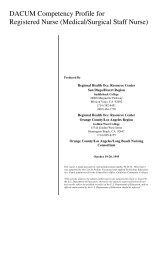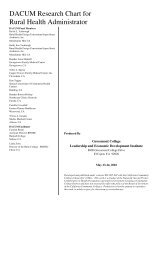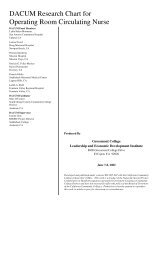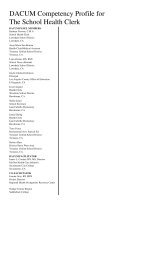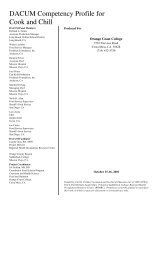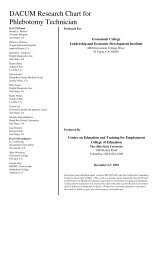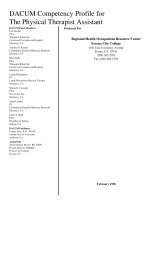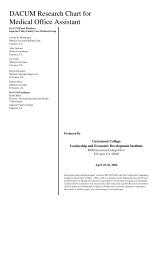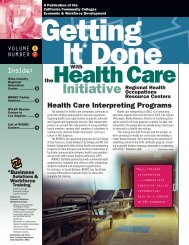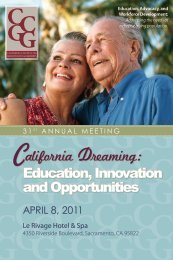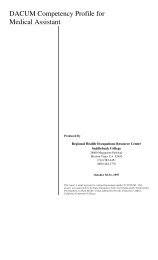Download - CA-HWI
Download - CA-HWI
Download - CA-HWI
You also want an ePaper? Increase the reach of your titles
YUMPU automatically turns print PDFs into web optimized ePapers that Google loves.
A Publication of the<br />
California Community Colleges<br />
Economic & Workforce Development<br />
4<br />
1<br />
Fall 2006<br />
Community<br />
College<br />
Sonography<br />
Graduates .......... 2<br />
RHORC Center<br />
Updates............... 3<br />
MIS Database<br />
Linked to<br />
BRN Survey......... 4<br />
List of Regional<br />
Health Occupations<br />
Resource<br />
Centers ............... 4<br />
the<br />
With<br />
Initiative<br />
This course has been designed as a self-paced course<br />
that individuals can utilize in preparation for entry into<br />
allied health programs at California Community Colleges.<br />
The topics covered focus specifically on the math skills<br />
necessary to be successful in an allied health occupational<br />
area such as nursing, respiratory therapy, radiological<br />
technology, etc. Tech Prep programs can also utilize this<br />
course as students in the high school prepare to enter<br />
health occupations programs at the college level.<br />
Regional Health<br />
Occupations<br />
Resource Centers<br />
Allied Health/Nursing Math Course<br />
This course can also be used by instructors to review math<br />
skills, ensure competency, and increase math skills through<br />
the use of the practice exercises.<br />
The development team consisted of Gene Sellers, Adjunct<br />
Instructor and Professor Emeritus Mathematics at<br />
Sacramento City College and Laurie Shepard, RN, MSN<br />
Nursing Instructor at Sacramento City College. Elwanda<br />
Gammill, MSN, MA, RN Professor Emeritus College of Marin<br />
Continued on inside.<br />
Allied Health & Nursing Math Course...<br />
Assists students in increasing math competency prior to entry<br />
into allied health programs at California Community Colleges<br />
Provides allied health instructors with a tool to assist students<br />
in achieving the math competency required for California<br />
Community College allied health programs
A Publication of the<br />
California Community Colleges<br />
Economic & Workforce Development<br />
Health Occupations Math Course<br />
Prepares Students, Aids Instructors<br />
“providing education and training<br />
programs to meet emerging demands<br />
for health care industry workers...”<br />
Continued from front.<br />
assisted the development team in review<br />
and editing.<br />
The Key Topics and subsections are<br />
illustrated with detailed examples and<br />
practice exercises. A detailed explanation<br />
is provided to explain in words what<br />
occurred at each step of the solving<br />
process. In addition, at the end of each<br />
chapter there are many Exercises that<br />
are keyed to the examples they illustrate.<br />
To obtain the Allied Health Math<br />
Course CD, contact Linda Zorn, Butte<br />
College RHORC at 530-879-9069 or<br />
ZornLi@butte.edu.<br />
TOPICS COVERED:<br />
• Introduction to Whole Numbers<br />
• Operations on Whole Numbers<br />
• Formulas and Equations<br />
• Introduction to Common Fractions<br />
• Operations on Common Fractions<br />
• Introduction to Decimal Fractions<br />
• Operations on Decimal Fractions<br />
• The Structure of the Metric System<br />
• Introduction to Percents<br />
• Calculations Involving Percents<br />
• Roman Numerals, Twenty-Four Hour Clock<br />
and Medications<br />
• Dimensional Analysis<br />
CHAPTER FORMAT:<br />
Applied Problem<br />
Pretest<br />
Key Topics including<br />
Practice Exercises<br />
Exercises<br />
Posttest<br />
First Community College Graduates<br />
of Sonography in Central California<br />
Nineteen students were recognized in<br />
a pinning ceremony and reception on<br />
August 23, honoring them as the first<br />
graduating class from Santa Barbara City<br />
College’s Diagnostic Medical Sonography<br />
(DMS) program. This is also the first<br />
graduating class of sonographers from a<br />
California Community College in the central<br />
third of the state. The program prepares<br />
students in the diagnostic procedure of<br />
sonography, also called ultrasound, used<br />
in the detection and treatment of diseases<br />
in virtually all body systems.<br />
The 14-month career ladder program<br />
(which was recently expanded to 18<br />
Below: Instructors Debra von Bernuth (back row, fourth from<br />
left), Nick Spina (far right) and Clinical Coordinator Carla<br />
Seder (second from right) join members of the first graduating<br />
class from SBCC’s Diagnostic Medical Sonography program.<br />
months) is a combination of classroom<br />
instruction and clinical experience primarily<br />
for those who have already completed a<br />
two-year training program in health<br />
occupations. Graduates receive a certificate<br />
of completion and are eligible to take the<br />
registry exams in sonography.<br />
SBCC’s DMS program was begun in June<br />
2005 in response to a long-term need<br />
identified by health care facilities for more<br />
Sonographers. After RHORC conducted a<br />
needs assessment, SBCC received an<br />
Economic and Workforce Development<br />
Industry-Driven Regional Collaborative<br />
grant to launch the program (facilitated<br />
by RHORC). Debra McMahan, Chair of the<br />
Radiographic and Imaging Sciences Dept.<br />
has taken the program from her vision<br />
through co-directing, to now integrating<br />
Pod-Casting to expand students’ access.<br />
A program director continues to be needed.<br />
Also honored at the graduation reception<br />
were some of the program’s preceptors.<br />
Preceptors are experienced professionals<br />
who serve as clinical instructors to new<br />
employees and students in a clinical<br />
setting. They assist with the transition into<br />
the clinical environment in order to insure<br />
quality patient services, maintenance of<br />
organization standards and continuity of<br />
patient care in a cost-effective manner.<br />
Marsha Roberson, Director of the South<br />
Coast RHORC (and Co-Program Director),<br />
thanked the DMS preceptors for meeting<br />
the challenge of adding a student to their<br />
routine and for their positive approach,<br />
commitment to education, and<br />
professionalism. “These students could<br />
not have learned how to scan without your<br />
expertise, guidance, and commitment,”<br />
she said.<br />
Well-trained preceptors who are provided<br />
some type of compensation for this added<br />
responsibility can be effective recruiters<br />
for the next generation of staff.<br />
Compensation can take the form of a lighter<br />
caseload of patients, moving up the clinical<br />
ladder with a salary differential, and/or a<br />
recognition event. Additionally, it is well<br />
recognized that when staff are provided<br />
the opportunity to grow and learn (as is<br />
the case when they complete preceptor<br />
training), they tend to stay in that facility.
San Diego/Imperial RHORC<br />
Robert Yarris, Director<br />
As a result of Proposition G, a<br />
$247 million General Obligation<br />
Bond, the San Diego RHORC 10<br />
Center Director is working in partnership<br />
with Grossmont HealthCare District and<br />
Grossmont College to develop a Regional<br />
Simulation Laboratory.<br />
The “San Diego Center for Collaborative<br />
Healthcare Planning” has resulted<br />
in a grant application to the California<br />
Endowment in response to the outcomes<br />
of the WFP Seven-Year Healthcare Projections<br />
Survey which was initiated by<br />
the WFP. The RHORC 10 Center Director<br />
is acting as co-chair.<br />
A third cohort for the Accelerated ADN<br />
RN Program has prompted discussions<br />
to institutionalize this curriculum at<br />
Grossmont College.<br />
A SB 70 grant for the Regional Allied<br />
Health and Science Initiative was awarded<br />
to Grossmont College in partnership<br />
with the San Diego School Districts. The<br />
goals are to improve science performance,<br />
increase health career awareness,<br />
and support allied health training.<br />
Los Angeles County RHORC<br />
Jesus Oliva, Director<br />
During this project period the<br />
RHORC has six projects in<br />
progress that are funded by resources<br />
leveraged outside the grant and through<br />
grants and contracts that total<br />
$2,692,828. Many strides were made<br />
with the Foreign Medical Graduates this<br />
project year. The RHORC-Welcome Back<br />
Center in partnership with the UCLA<br />
Family Practice Medical Residency program,<br />
offered a cohort of participants<br />
the opportunity to enter into a Pre-<br />
Residency program. The Nursing Pathway,<br />
developed by the LA RHORC, established<br />
the center as a “one-stop for<br />
nurses.” The resource center, case management<br />
services and review courses<br />
have led to the success of 138 nurses<br />
passing their state board exam and obtaining<br />
employment.<br />
Orange/Inland Empire RHORC<br />
Mary O’Connor, Director<br />
The focus for the RHORC<br />
Region 8 this year will be<br />
faculty development. Several programs<br />
are planned including: “A Framework for<br />
Understanding Poverty” on November<br />
1–2, 2006 in San Bernardino; “Using<br />
Simulation Technology as a Teaching<br />
Strategy” for Orange/Inland Empire<br />
METI users on January 11–12, 2007;<br />
“Creative Teaching Strategies for<br />
Health Occupations Educators” with<br />
Michele Deck on January 29, 2007 in<br />
Ontario; and the 11th Annual Health<br />
Occupations Educator Institute on April<br />
23–25, 2007 in Santa Ana.<br />
The September Preceptor Instructor<br />
course (train-the-trainer course) in Irvine<br />
was very successful with 17 participants.<br />
More will be planned as needed.<br />
Critical Care Nursing and Telemetry<br />
courses are planned for winter/spring,<br />
summer, and fall. Currently 15 hospitals<br />
are participating. Summer/Fall programs<br />
enrolled 122 nurses, including many new<br />
graduate nurses.<br />
The revised Resource Manual on<br />
Mentoring is now available. New curriculum<br />
projects for 2006-07 include a selfstudy<br />
ECG Interpretation CD and updating<br />
the Medical Assistant curriculum.<br />
South Coast RHORC<br />
Marsha Roberson, Director<br />
The Southcoast RHORC is in<br />
the 2nd year of the Governor’s<br />
WIA grant with five partnering colleges.<br />
An additional 44 students have been<br />
enrolled in A.D. Nursing programs this<br />
year. A NCLEX Return on Investment Summary<br />
was prepared to demonstrate the<br />
cost-effectiveness of growing employers’<br />
own RNs from foreign-educated nurses<br />
who are working as nurse assistants and<br />
LVNs. Employers offering one day off/week<br />
for nurses to complete the NCLEX Success<br />
for Repeat Test-takers course can make<br />
the difference in nurses’ success (courses<br />
in February and March ’06). Collaboration<br />
with industry partners and Moorpark<br />
College is in progress to offer a costeffective,<br />
consolidated preceptor course.<br />
Regional planning is in progress<br />
for meeting industry needs in Radiographic<br />
Technology as well as for pandemic<br />
influenza preparation.<br />
Program support is being provided to<br />
Allan Hancock College (co-supporting<br />
C.N.A. instructor position), Antelope Valley<br />
and College of the Canyons (new training<br />
programs), Cuesta (paramedic equipment<br />
& alcohol/drug training needs<br />
assessment), and SBCC (Sonography).<br />
South Bay Region RHORC<br />
Matthew Grayson, Director<br />
South Bay RHORC, North Valley<br />
Workforce Improvement Board<br />
(NOVA), and Bay Area Workforce Collaborative<br />
Fund (BAWFC) combined resources<br />
to offer 17 additional courses in<br />
Nutrition, Anatomy, Physiology, and Microbiology<br />
at eight different community<br />
colleges, serving over 450 students, June<br />
2005 to July 2006. Over 1,500 surveys<br />
were collected from students to determine<br />
their intended educational plans. Students<br />
were asked if they have applied or<br />
intended to apply into nursing, Radiology<br />
Technologist, respiratory therapy, medical<br />
lab technician, dental hygiene, or other<br />
Allied Health program. Information may<br />
prove to be useful to administrators and<br />
planners to predict growth or decline in<br />
health occupation programs by tracking<br />
enrollment trends in prerequisite courses.<br />
Simulation education may resolve<br />
nursing and allied health capacity issues<br />
for California while increasing the<br />
performance of recent graduates entering<br />
the workforce. The Betty Gordon and<br />
Moore Foundation sponsored the development<br />
of five simulation education<br />
centers located throughout the Bay Area.<br />
South Bay RHORC in support of this<br />
project has and will provide faculty<br />
development workshops. Faculty development<br />
on how to use and infuse the<br />
education methodology into the<br />
curriculum is critical to successful<br />
implementation.<br />
Interior Bay RHORC<br />
Janey Skinner, Director<br />
The Interior Bay Area RHORC<br />
announces the appointment of<br />
a new Director, Janey Skinner, MPH, who<br />
is already involved with several new<br />
projects: supporting Radiologic Technology<br />
education through the fall RTEC/CSRT<br />
conferences; working with Kaiser Permanente<br />
and two colleges to expand training<br />
of healthcare interpreters; assisting with<br />
a career ladders project in Livermore;<br />
and co-convening a regional workgroup<br />
of colleges and employers on training in<br />
response to the Mental Health Services<br />
Act. This RHORC is also heading up a<br />
cross-Bay collaborative for training frontline<br />
health and human service workers,<br />
involving numerous employers, City<br />
College of San Francisco and Berkeley<br />
City College.<br />
Central RHORC<br />
Juliet Atkins, Director<br />
Kathleen Schrader RN, PhD<br />
Director of the Central Region<br />
RHORC, has taken a position as Dean of<br />
Math, Sciences and Health Professions<br />
at Hartnell College in Salinas, <strong>CA</strong>. In her<br />
place Hartnell has named Juliet Atkins,<br />
RN as Interim Director. Juliet comes to<br />
RHORC with a strong background and a<br />
great amount of experience in the areas<br />
of critical care and trauma nursing. Juliet<br />
is working on several grant funded<br />
projects as director and is in the process<br />
of constructing a team, which will involve<br />
several colleges, to offer two pilot programs;<br />
Medical Laboratory Technician<br />
(MLT) and Certified Coding specialist<br />
which will be offered as distance education<br />
programs statewide.<br />
North/Far North RHORC<br />
Linda Zorn, Director<br />
Linda Zorn, Director of the<br />
Butte College RHORC provided<br />
a workshop on Test Construction for the<br />
region presented by Bette Case Di Leonardi,<br />
Ph.D., R.N., B.C., with over 50<br />
participants. By popular request, Fred<br />
Lee will be presenting his workshop “If<br />
Disney Ran Your Hospital, Some Things<br />
You Would do Differently” on February 2,<br />
2007 in Chico. An ultrasound/sonography<br />
labor market survey was completed for<br />
Yuba College. The Home Health Aide<br />
Curriculum has been revised by the Marshall<br />
Medical Center Home Health Agency.<br />
The Northstate Rural Workforce<br />
Collaborative, formed May 12, is moving<br />
ahead with goals, objectives, and grant<br />
applications. RHORC is sponsoring participation<br />
at the Curriculum Mapping<br />
workshop to link high school and community<br />
college outcomes.
BRN Survey Management Information System<br />
The California Board of Registered<br />
Nursing in cooperation with the<br />
California Community Colleges and the<br />
Moore Foundation has developed a<br />
comprehensive Annual Nursing Program<br />
Survey for the nursing programs<br />
in California. A multi-disciplinary team<br />
of representatives of Associate Degree<br />
Nursing Programs, Baccalaureate<br />
Nursing programs, the California Board<br />
of Registered Nursing, and the<br />
California Community Colleges<br />
Chancellor’s Office met on an ongoing<br />
basis to develop the instrument. The<br />
survey is an attempt to consolidate<br />
into one master survey to meet the<br />
needs of a variety of stakeholders for<br />
information regarding the “pipeline”<br />
of Registered Nurses in California<br />
Schools of Nursing. Due to the<br />
increased interest in the status of<br />
Nursing program applicants and<br />
graduates in California a variety of<br />
groups were seeking information on<br />
pipeline statistics from the Chancellors’<br />
Office, the BRN, and from nursing<br />
program directors directly. This data<br />
was required to assist policy makers<br />
make decisions about the nature of the<br />
“...a<br />
comprehensive<br />
Management<br />
Information<br />
System<br />
directly<br />
aligned to<br />
the questions<br />
asked in the<br />
California<br />
Board of<br />
Registered<br />
Nurses<br />
Survey.”<br />
projected nursing shortage in California<br />
and the ability of the existing programs<br />
to produce sufficient graduates to meet<br />
the need for increased numbers of<br />
nurses as well as provide a culturally<br />
diverse nursing workforce.<br />
The types of data required included<br />
statistics regarding the age, gender,<br />
and demographics of entering nursing<br />
students as well as graduates.<br />
Additional information was requested<br />
of the survey respondents regarding<br />
the success rates of students in nursing<br />
programs as well. Information on the<br />
nature and demography of the existing<br />
nursing faculty was also requested.<br />
Concern was expressed by members<br />
of the survey design committee<br />
regarding the availability of the data<br />
to complete the survey for nursing<br />
program directors. Rapid access to<br />
information of this nature is not readily<br />
available to nursing programs directors.<br />
It was felt that completion of the survey<br />
might prove a difficult task for already<br />
overburdened nursing program<br />
directors dealing with the logistics and<br />
implementation of a variety of program<br />
expansion grants across the state.<br />
Regional Health Occupations<br />
Resource Centers<br />
To address the issue, the EWD Health<br />
Care Initiative Director, a member of<br />
the BRN Education Advisory Committee,<br />
developed a comprehensive<br />
Management Information System<br />
directly aligned to the questions asked<br />
in the BRN Survey. The program runs<br />
on a PC in a Windows environment. MS<br />
Access 2003 is the database system<br />
required to run the program. To ensure<br />
rapid deployment of the system and<br />
increase ease of use, a documentation<br />
manual was developed to guide the<br />
user in running the program. The user<br />
manual also includes a “cross-walk”<br />
for the program explaining which<br />
reports answer which survey questions.<br />
The MIS System is available from the<br />
EWD Health Initiative Office at<br />
Sacramento City College at (916) 558-<br />
2569 or by email to Jim Comins, EWD<br />
Healthcare Initiative Director at<br />
cominsj@scc.losrios.edu. It can also<br />
be downloaded along with the<br />
documentation manual in the form of<br />
an executable Zip file from the<br />
Statewide Health Occupations Website<br />
at www.healthoccupations.org.<br />
North/Far North RHORC<br />
Butte College<br />
2050 Talbert Drive, Suite 300<br />
Chico, <strong>CA</strong> 95928<br />
Phone: (530) 879-9069<br />
Fax: (530) 879-0179<br />
Email: zornli@butte.edu<br />
Interior Bay RHORC<br />
City College of San Francisco<br />
1600 Holloway Avenue, HSS 301<br />
San Francisco, <strong>CA</strong> 94132-4161<br />
Phone: (415) 405-0777<br />
Fax: (415) 338-7948<br />
Email: rhorc@sfsu.edu<br />
San Diego/Imperial RHORC<br />
Grossmont College<br />
8800 Grossmont College Drive,<br />
Building 343-C<br />
El Cajon, <strong>CA</strong> 92020<br />
Phone: (619) 644-7057<br />
Fax: (619) 644-7058<br />
Email: bob.yarris@gcccd.edu<br />
Central RHORC<br />
Hartnell College<br />
156 Homestead Avenue<br />
Salinas, <strong>CA</strong> 93901<br />
Phone: (831) 770-6102<br />
Fax: (831) 759-6058<br />
Email: jatkins@hartnell.cc.ca.us<br />
South Bay RHORC<br />
Mission College<br />
3000 Mission College Blvd., MS #1<br />
Santa Clara, <strong>CA</strong> 95054-1897<br />
Phone: (408) 855-5215<br />
Fax: (408) 980-9540<br />
Email: matthew_grayson<br />
@wvmccd.ca.us<br />
Los Angeles County RHORC<br />
Mt. San Antonio Community College<br />
1100 N. Grand Avenue, Building 35<br />
Walnut, <strong>CA</strong> 91789<br />
Phone: (909) 594-5611 x6101<br />
Fax: (909) 468-4093<br />
Email: joliva@mtsac.edu<br />
Orange/Inland Empire RHORC<br />
Golden-West College<br />
15744 Golden-West Street<br />
Huntington Beach, <strong>CA</strong> 92647<br />
Phone: (714) 895-8975<br />
Fax: (714) 895-8976<br />
Email: terrymaryo@sbcglobal.net<br />
South Coast RHORC<br />
Santa Barbara City College<br />
721 Cliff Drive<br />
Santa Barbara, <strong>CA</strong> 93109-9990<br />
Phone: (805) 965-0581 x2782<br />
Fax: (805) 730-8740<br />
Email: roberson@sbcc.edu<br />
Health Care Website:<br />
http://www.healthoccupations.org<br />
Director: Jim Comins<br />
Phone: (916) 558-2569<br />
Fax: (916) 558-2098<br />
Email: cominsj@scc.losrios.edu<br />
Visit our website at www.cccewd.net<br />
Call Toll Free: 1-800-344-3812<br />
Vol.4 No.1 10-29-06



